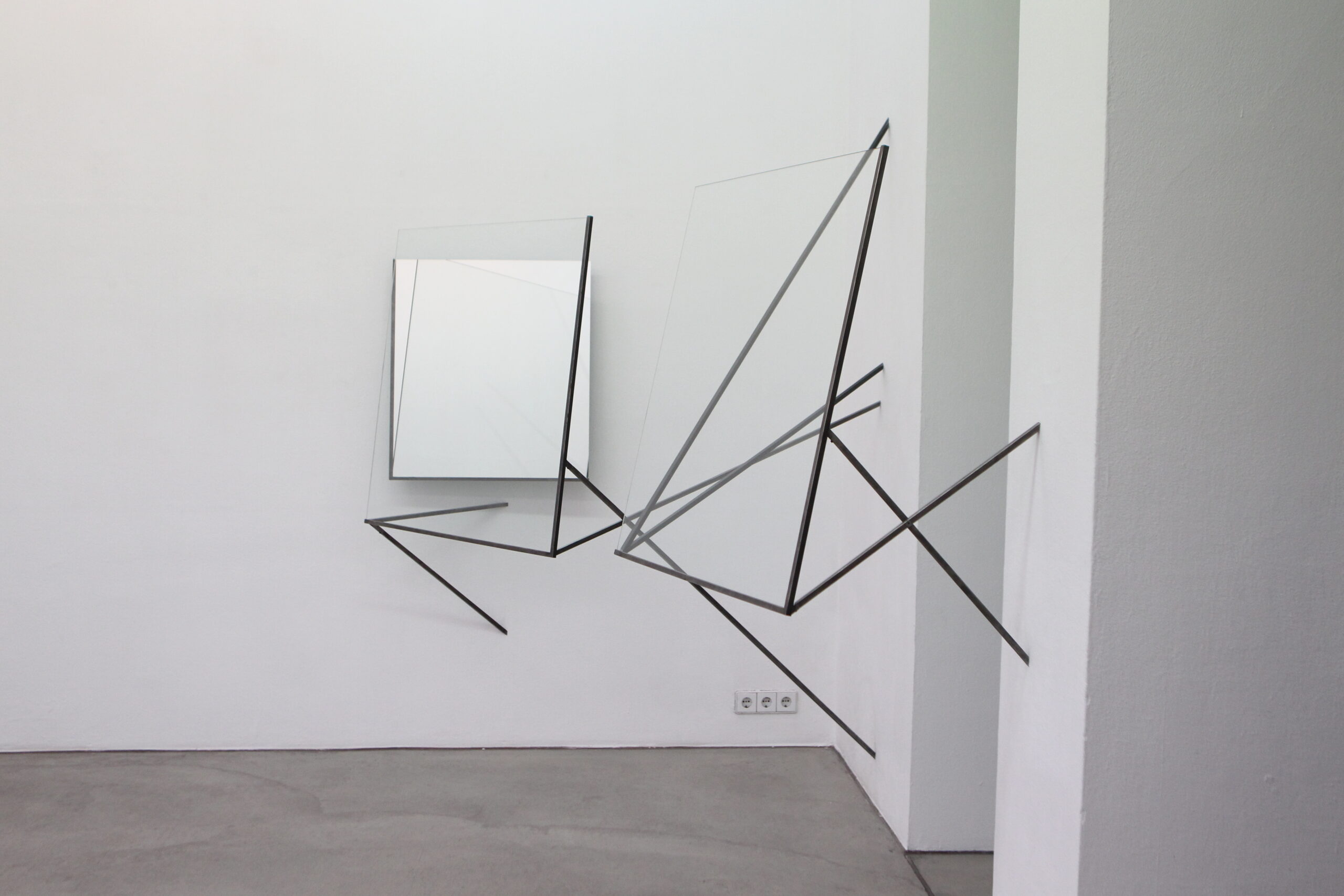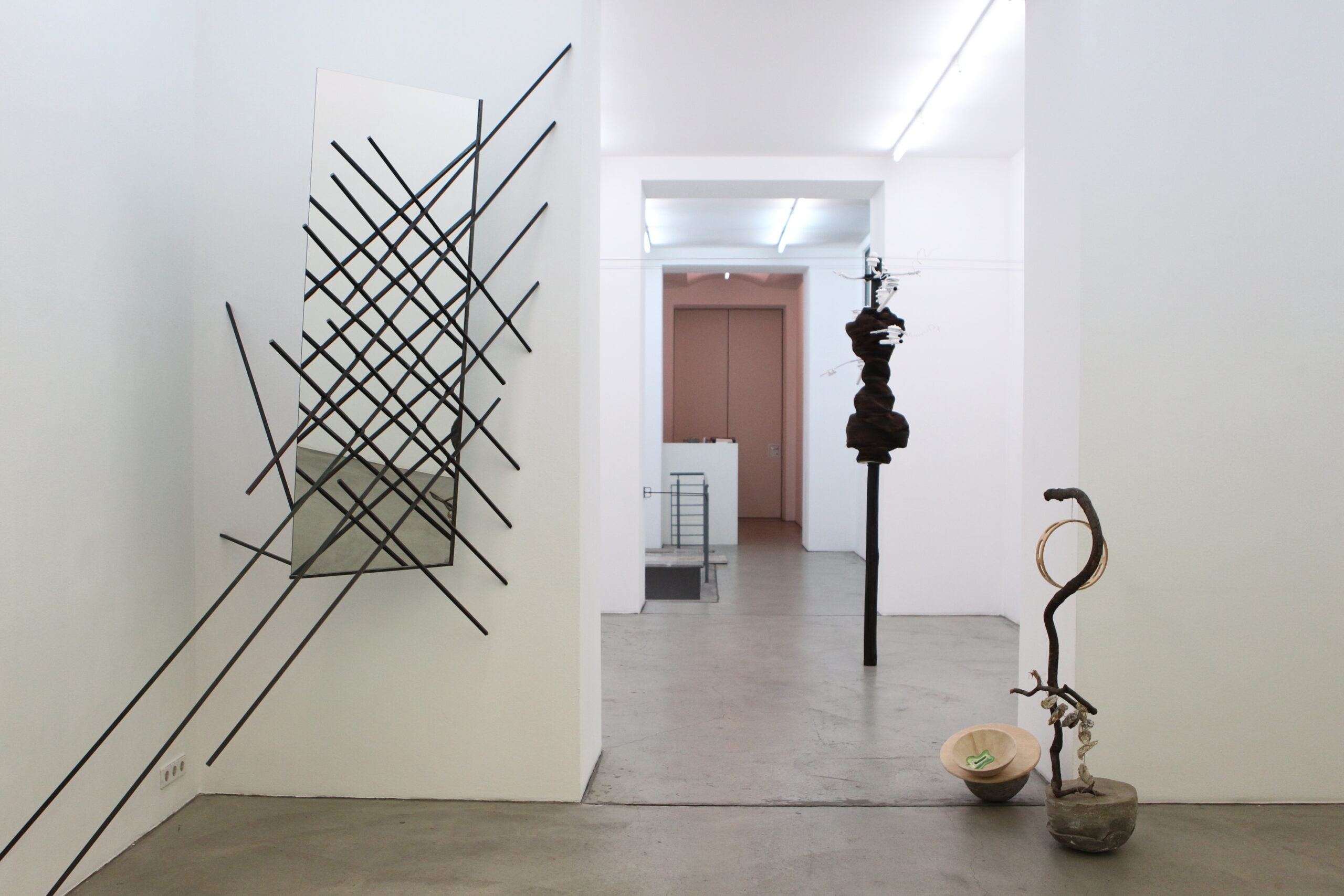
Cäcilia Brown Michèle Pagel Sabrina Peer Heidi Rada
curated by Katharina Senn
Es soll hier vor allem von Übergängen die Rede sein, von jenen Nahtstellen und Randzonen, an denen sich Konfrontationen von trennenden und verbindenden Elementen manifestieren, die Bereiche sind gewissermaßen die Zonen, in denen jene Ambivalenz wirksam wird, welche die wesentlichen Qualitäten der Arbeiten der ausgestellten Künstlerinnen verbindet.
In Sabrina Peers raumgreifender Wandinstallation verdichten sich die Momente der Perspektiven durch den Einsatz von Materialien wie Glas und Spiegel. Es verschwimmen die Grenzen zwischen dem Drinnen und dem Draußen.
Cäcilia Brown zeigt eine Installation aus Materialien wie Beton und Eisen und verbaut und verfremdet durch ihre Installation die Stiege, welche die Galerie mit dem Untergeschoss verbindet.
In Heidi Radas Arbeit geht es um Kommunikation. Die Skulptur, welche die Künstlerin aus persönlichen Schriftstücken modelliert und mit heißer Kohle formt, steht nur scheinbar als verbranntes Monument der Erinnerung.
Michèle Pagel zeigt aus ihrem pseudoallegorischen Werkkomplex von faltbaren Skulpturen zwei Arbeiten: “EUROPA ORBATA LUGENS AFRIKA INDIGNATA FREMENS ASIA EXANIMATA SUSPIRANS AMERICA AFFLICTA GEMENS “.
Diesen reliefartigen, mobilen Wandarbeiten wird eine autonome Skulpturengruppe “antroposophischer Betonaufsteher” entgegen gehalten.
In den Dimensionen der Fläche und denen des Raumes angesiedelt, quasi als eine Form der Herausforderung, sind die Arbeiten einerseits in Traditionen verankert und andererseits ermöglicht es ihnen die verschiedensten Kunstpositionen nach ihren behaupteten Werten zu befragen und in neuen Formulierungen aufleben zu lassen. Das in der Folge dieser Auseinandersetzung auch die in Frage gestellten traditionellen Werte ganz selbstverständlich mit neuen Energien angereichert werden, scheint dabei ein nicht unwesentliches Faktum zu sein. Es ist für die raumbezogenen Beispiele modifizierend hinzuzufügen, dass diese sich nicht im herkömmlichen Sinn nur locker auf die architektonischen Gegebenheiten beziehen.
Die Klarheit der jeweiligen Anordnung und die bezwingende Gewalt ihrer Präsenz lässt die einzelnen Arbeiten subkutan jene physikalischen Grenzen spürbar machen.

It is mainly transitions that shall be addressed in the following, those junctions and fringe areas where confrontations between partitioning and intertwining elements become manifest; these areas are – so to say – spheres where the sense of ambivalence operates, that sense that links the essential qualities of the works of art that are exhibited.
In Sabrina Peer’s expansive wall installation the moments of perspective become even more intense through the use of materials such as glass and mirrors. The lines between the interior and the exterior become blurry.
Cäcilia Brown shows an installation consisting of materials such as concrete and iron and, thus, shields and distorts the stairs that links the gallery with the basement.
Heidi Rada’s works deal with communication. The sculpture which the artist has modelled from personal writings and formed with hot coal only appears to represent a burned monument of memories.
Michèle Pagel has chosen two works from her pseudo-allegorical oeuvre of foldable sculptures: “EUROPA ORBATA LUGENS AFRIKA INDIGNATA FREMENS ASIA EXANIMATA SUSPIRANS AMERICA AFFLICTA GEMENS”. These relief-like, mobile wall works are contrasted by an autonomous group of sculptures, the “antroposophical concrete risers”.
These works, embedded in the dimensions of the surface and those of the room, just like some form of challenge, are, on the one hand, anchored in traditions and, on the other hand, allowed to question the alleged values of the various artistic positions, reviving them in new formulations. It seems that the consequence of this debate, the fact that the traditional values put into question are almost naturally enriched with new energy, is not just a side-effect of this process. As concerns the space-related examples, one needs to add a minor modification insofar as they are not to be seen as a casual reference to the architectonic conditions in the conventional sense. It is the purity of the respective order as well as the compelling power of its presence that permit the individual works to render, albeit subcutaneously, those physical limits more perceptible.
